Growth Enhancement of Camellia sinensis with Biochar
Abstract
:1. Introduction
2. Materials and Methods
2.1. Field Experimental Site
2.2. Biochar Production and Characteristics
2.3. Soil Properties Analysis
2.4. Tea Yield Analysis
2.5. Statistical Analysis of Data
3. Results
3.1. Biochar Characteristics
3.2. The Responses of Tea Yield
3.3. Biochar Effects on Soil Characteristic
3.4. Relationship between Tea Yield and Soil Status
4. Discussion
5. Conclusions
Author Contributions
Funding
Institutional Review Board Statement
Informed Consent Statement
Data Availability Statement
Acknowledgments
Conflicts of Interest
Appendix A
| W-N | W-B | CK-N | CK-B | Date | |
|---|---|---|---|---|---|
| Soil EC, mS cm−1 | 0.10 | 0.08 | 0.15 | 0.16 | November 2019 |
| 0.10 | 0.10 | 0.11 | 0.14 | June 2020 | |
| 0.18 | 0.13 | 0.18 | 0.20 | August 2020 | |
| 0.19 | 0.21 | 0.20 | 0.21 | November 2020 | |
| 0.22 | 0.25 | 0.25 | 0.28 | March 2021 | |
| Soil WHC, % | 50.0 | 47.8 | 70.0 | 53.3 | November 2019 |
| 45.7 | 54.9 | 64.7 | 48.2 | June 2020 | |
| 42.1 | 51.0 | 54.1 | 50.3 | August 2020 | |
| 37.8 | 53.7 | 37.0 | 53.3 | November 2020 | |
| 42.3 | 56.1 | 34.9 | 57.2 | March 2021 | |
| Soil OM, % | 3.70 | 3.57 | 4.07 | 2.83 | November 2019 |
| 4.33 | 4.27 | 4.20 | 4.20 | June 2020 | |
| 4.80 | 4.73 | 4.53 | 4.73 | August 2020 | |
| 5.33 | 5.80 | 4.40 | 5.67 | November 2020 | |
| 5.40 | 6.07 | 6.27 | 6.93 | March 2021 | |
| Extractable P, mg g−1 | 69 | 53 | 73 | 53 | April 2019 |
| 134 | 112 | 123 | 112 | June 2020 | |
| 113 | 125 | 111 | 125 | August 2020 | |
| 107 | 132 | 103 | 132 | November 2020 | |
| 167 | 284 | 256 | 284 | March 2021 | |
| Extractable N, mg g−1 | 15.8 | 11.5 | 18.9 | 15.8 | April 2019 |
| 14.9 | 9.3 | 15.5 | 11.7 | June 2020 | |
| 9.4 | 10.0 | 8.6 | 5.6 | August 2020 | |
| 7.4 | 8.8 | 7.5 | 9.6 | November 2020 | |
| 11.2 | 11.0 | 7.6 | 12.7 | March 2021 | |
| Soil pH | 4.4 | 4.1 | 4.3 | 4.2 | November 2019 |
| 4.4 | 4.3 | 4.2 | 4.1 | June 2020 | |
| 4.5 | 4.4 | 4.3 | 4.3 | August 2020 | |
| 4.5 | 4.7 | 4.1 | 4.3 | November 2020 | |
| 4.2 | 5.2 | 4.1 | 4.5 | March 2021 |
References
- Lehmann, J.; Joseph, S. Biochar for Environmental Management: Science and Technology; Earthscan: London, UK, 2009. [Google Scholar]
- Kimetu, J.M.; Lehmann, J. Stability and stabilization of biochar and green manure in soil with different organic carbon contents. Aust. J. Soil Res. 2010, 48, 577–585. [Google Scholar] [CrossRef]
- Bruun, E.W.; Hauggaardd-Nielsen, H.; Ibradhim, N.; Egsgaard, H.; Ambus, P.; Jensen, A.P.; Dam-Johansen, K. Influence of fast pyrolysis temperature on biochar labile fraction and short-term carbon loss in a loamy soil. Biomass Bioenergy 2011, 35, 1182–1189. [Google Scholar] [CrossRef]
- De la Rosa, J.M.; Paneque, M.; Miller, A.Z.; Knicker, H. Relating physical and chemical properties of four different biochars and their application rate of biomass production of Lolium perenne on a Calcic Cambisol during a pot experiment of 79 days. Sci. Total Environ. 2014, 499, 175–189. [Google Scholar] [CrossRef] [Green Version]
- Novak, J.M.; Busscher, W.J.; Laird, D.L.; Ahmedna, M.; Watts, D.W.; Niandou, M.A.S. Impact of biochar amendment on fertility of a South-eastern coastal plain soil. Soil Sci. 2009, 174, 105–112. [Google Scholar] [CrossRef] [Green Version]
- Woolf, D.; Amonette, J.E.; Street-Perrott, F.A.; Lehmann, J.; Joseph, S. Sustainable biochar to mitigate global climate change. Nat. Commun. 2010, 1, 56. [Google Scholar] [CrossRef] [PubMed] [Green Version]
- Du, Z.L.; Zhao, J.K.; Wang, Y.D.; Zhang, Q.Z. Biochar addition drives soil aggregation and carbon sequestration in aggregate fractions from an intensive agricultural system. J. Soils Sediments 2017, 17, 581–589. [Google Scholar] [CrossRef]
- Zhang, Y.L.; Chen, H.; Bai, S.H.; Menke, C.; Zhang, M.Y.; Xu, Z.H. Interactive effects of biochar addition and elevated carbon dioxide concentration on soil carbon and nitrogen pools in mine spoil. J. Soils Sediments 2017, 17, 2400–2409. [Google Scholar] [CrossRef]
- Zhang, J.; Sun, C.; Liu, G.; Xue, S. Effects of long-term fertilization on aggregates and dynamics of soil organic carbon in a semi-arid agro-ecosystem in China. PeerJ 2018, 6, e4758. [Google Scholar] [CrossRef] [PubMed]
- Pokharel, P.; Kwak, J.-H.; Ok, Y.S.; Chang, S.X. Pine sawdust biochar reduces GHG emission by decreasing microbial and enzyme activities in forest and grassland soils in a laboratory experiment. Sci. Total Environ. 2018, 625, 1247–1256. [Google Scholar] [CrossRef]
- Gunina, A.; Kuzyakov, Y. Pathways of litter C by formation of aggregates and SOM density fractions: Implications from 13C natural abundance. Soil Biol. Biochem. 2014, 71, 95–104. [Google Scholar] [CrossRef]
- El-Naggar, A.; Awad, Y.M.; Tang, X.Y.; Liu, C.; Niazi, N.K.; Jien, S.H.; Tsang, D.C.W.; Song, H.C.; Ok, Y.S.; Lee, S.S. Biochar influences soil carbon pools and facilitates interactions with soil: A field investigation. Land Dev. Degrad. 2018, 29, 2162–2171. [Google Scholar] [CrossRef]
- Prendergast-Miller, M.T.; Michael, D.; Saran, P.S. Localisation of nitrate in the rhizosphere of biochar-amended soils. Soil Biol. Biochem. 2011, 43, 2243–2246. [Google Scholar] [CrossRef]
- Zhang, H.; Chen, C.; Gray, E.M.; Boyd, S.E. Roles of biochar in improving phosphorus availability in soils: A phosphate adsorbent and a source of available phosphorus. Geoderma 2016, 276, 1–6. [Google Scholar] [CrossRef]
- Tan, Z.; Ye, Z.; Zhang, L.; Huang, Q. Application of the 15N tracer method to study the effect of pyrolysis temperature and atmosphere on the distribution of biochar nitrogen in the biomass–biochar-plant system. Sci. Total Environ. 2018, 622, 79–87. [Google Scholar] [CrossRef]
- Xie, Z.; Xu, Y.; Liu, G.; Zhu, Z.; Tu, C.; Amonette, J.E.; Cadisch, G.; Yong, J.W.H.; Hu, S. Impact of biochar application on nitrogen nutrition of rice, greenhouse-gas emissions and soil organic carbon dynamics in two paddy soils of China. Plant Soil 2013, 370, 527–540. [Google Scholar] [CrossRef]
- Zhu, S.; Huang, X.; Ma, F.; Wang, L.; Duan, X.; Wang, S. Catalytic removal of aqueous contaminants on N-doped graphitic biochars: Inherent roles of adsorption and nonradical mechanisms. Environ. Sci. Technol. 2018, 52, 8649–8658. [Google Scholar] [CrossRef] [PubMed]
- Dari, B.; Nair, V.D.; Harris, W.G.; Nair, P.K.R.; Sollenberger, R.; Mylavarapu, R. Relative influence of soil- vs. biochar properties on soil phosphorus retention. Geoderma 2016, 280, 82–87. [Google Scholar]
- FAOSTAT. Food and Agriculture Organization of the United Nations. Production: Crops. 2019. Available online: http://faostat.fao.org (accessed on 25 December 2021).
- Pal, D.; Maiti, S.K. Abatement of cadmium (Cd) contamination in sediment using tea waste biochar through meso-microcosm study. J. Clean. Prod. 2019, 212, 986–996. [Google Scholar] [CrossRef]
- Vithange, M.; Mayakaduwa, S.S.; Herath, I.; Ok, Y.S.; Mohan, D. Kinetics, thermodynamics and mechanistic studies of carbofuran removal using biochars from tea waste and rice husks. Chemosphere 2016, 150, 781–789. [Google Scholar] [CrossRef] [PubMed]
- Rajapaksha, A.U.; Vithanage, M.; Zhang, M.; Ahmad, M.D.; Chang, S.X.; Ok, Y.S. Pyrolysis condition affected sulfamethazine sorption by tea waste biochars. J. Bioresour. Technol. 2014, 166, 303–308. [Google Scholar] [CrossRef] [PubMed]
- Yan, P.; Wu, L.; Wang, D.; Fu, J.; Shen, C.; Li, X.; Zhang, L.; Zhang, L.P.; Fan, L.C.; Han, W.Y. Soil acidification in Chinese tea plantations. Sci. Total Environ. 2020, 715, 136963. [Google Scholar] [CrossRef]
- Han, W.; Ruan, J.; Lin, Z. The major nutrient limiting factors in tea soils and development of series tea specialty fertilizers. J. Tea Sci. Res. 2002, 22, 70–74. [Google Scholar]
- Ni, K.; Liao, W.; Yin, X.; Niu, S.; Ma, L.; Shi, Y.; Zhang, Q.; Liu, M.; Ruan, J. Fertilization status and reduction potential in tea gardens of China. J. Plant Nutr. Fertil. 2019, 25, 421–432. [Google Scholar]
- Su, H.G. The improvement measures of soil acidification in tea garden in Anxi. Guangdong Tea Ind. 2012, 1, 31–32. [Google Scholar]
- Yan, P.; Chen, S.; Zhenhao, Z.; Jianyu, F.; Xin, L.; Liping, Z.; Lan, Z.; Wenyan, H.; Lichao, F. Biochar stimulates tea growth by improving nutrients in acidic soil. Sci. Hortic. 2021, 283, 110078. [Google Scholar] [CrossRef]
- Fageria, N.K.; Nascente, A.S. Chapter six–management of soil acidity of South American soils for sustainable crop production. Adv. Agron. 2014, 128, 221–275. [Google Scholar]
- Holland, J.E.; Bennett, A.E.; Newton, A.C.; White, P.J.; Mckenzie, B.M. Liming impacts on soils, crops and biodiversity in the UK: A review. Sci. Total Environ. 2017, 610, 316–332. [Google Scholar] [CrossRef] [PubMed]
- Kunhikrishnan, A.; Thangarajan, R.; Bolan, N.; Xu, Y.; Mandal, S.; Gleeson, D.; Seshadri, B.; Zaman, M.; Barton, L.; Tang, C. Functional relationships of soil acidification, liming, and greenhouse gas flux. Adv. Agron. 2016, 139, 1–71. [Google Scholar]
- Barrow, N.J. The effects of pH on phosphate uptake from the soil. Plant Soil 2017, 410, 401–410. [Google Scholar] [CrossRef]
- Yao, Y.T.; Song, L.B.; Tian, L.L. Advances in research on calcium nutrition of tea. Deciduous Fruits 2011, 2, 37–39. [Google Scholar]
- Shen, J.Z.; Hu, J.H. Variation of biochemical components in different tea varieties under excessive calcium treatment. Shandong Agric. Sci. 2014, 46, 74–76. [Google Scholar]
- Watanabe, I.; Tokuda, S.; Nonaka, K. Nutrients leaching losses from lysimeter grown tea plants fertilized at two rates of nitrogen. Chagyo Kenkyu Hokoku 2009, 94, 1–6. [Google Scholar] [CrossRef] [Green Version]
- Chen, C.F.; Lin, J.Y. Estimating the gross budget of applied nitrogen and phosphorus in tea plantations. Sustain. Environ. Res. 2016, 26, 124–130. [Google Scholar] [CrossRef] [Green Version]
- Chen, D.; Li, Y.; Wang, C. Measurement and modeling of nitrous and nitric oxide emissions from a tea field in subtropical central China. Nutr. Cycl. Agroecosyst. 2017, 107, 157–173. [Google Scholar] [CrossRef]
- Li, Y.; Fu, X.; Liu, X. Spatial variability and distribution of N2O emissions from a tea field during the dry season in subtropical central China. Geoderma 2013, 193, 1–12. [Google Scholar] [CrossRef]
- Yan, P.; Shen, C.; Fan, L.C.; Li, X.; Zhang, L.; Zhang, L.P.; Han, W.Y. Tea planting affects soil acidification and nitrogen and phosphorus distribution in soil. Agric. Ecosyst. Environ. 2018, 254, 20–25. [Google Scholar] [CrossRef]
- Jeffery, S.; Verheijen, F.G.A.; van der Velde, M.; Bastos, A.C. A quantitative review of the effects of biochar application to soils on crop productivity using meta-analysis. Agric. Ecosyst. Environ. 2011, 144, 175–187. [Google Scholar] [CrossRef]
- Gul, S.; Whalen, J.K. Biochemical cycling of nitrogen and phosphorus in biochar amended soils. Soil Biol. Biochem. 2016, 103, 1–15. [Google Scholar] [CrossRef]
- Purakayastha, T.J.; Bera, T.; Bhaduri, D. A review on biochar modulated soil condition improvements and nutrient dynamics concerning crop yields: Pathways to climate change mitigation and global food security. Chemosphere 2019, 227, 345–365. [Google Scholar] [CrossRef] [PubMed]
- Raboin, L.M.; Razafmahafaly, A.H.D.; Rabenjarisoa, M.B. Improving the fertility of tropical acid soils: Liming versus biochar application? A long-term comparison in the highlands of Madagascar. Field Crops Res. 2016, 199, 99–108. [Google Scholar]
- Yuan, J.H.; Xu, R.K.; Qian, W.; Wang, R.H. Comparison of the ameliorating effects on an acidic ultisol between four crop straws and their biochars. J. Soils Sediments 2011, 11, 741–750. [Google Scholar] [CrossRef]
- Ding, Y.; Liu, Y.; Liu, S.; Li, Z.; Tan, X.; Huang, X.; Zeng, G.; Zhou, L.; Zheng, B. Biochar to improve soil fertility. Rev. Agron. Sustain. Dev. 2016, 36, 36. [Google Scholar] [CrossRef] [Green Version]
- Kanthle, A.K.; Lenka, N.K.; Lenka, S. Biochar impact on nitrate leaching as influenced by native soil organic carbon in an Inceptisol of central India. Soil Tillage Res. 2016, 157, 65–72. [Google Scholar] [CrossRef]
- Xu, N.; Tan, G.; Wang, H. Effect of biochar additions to soil on nitrogen leaching, microbial biomass and bacterial community structure. Eur. J. Soil Biol. 2016, 74, 1–8. [Google Scholar] [CrossRef]
- Haider, G.; Steffens, D.; Moser, G. Biochar reduced nitrate leaching and improved soil moisture content without yield improvements in a four-year field study. Agric. Ecosyst. Environ. 2017, 237, 80–94. [Google Scholar] [CrossRef]
- Marks, A.; Mattana, S.; AlcaIz, J.M.; P’erez-Herrero, M.; Domene, X. Gasifier biochar effects on nutrient availability, organic matter mineralization, and soil fauna activity in a multi-year Mediterranean trial. Agric. Ecosyst. Environ. 2016, 215, 30–39. [Google Scholar] [CrossRef]
- Olmo, M.; Villar, R.; Salazar, P.; Alburquerque, J.A. Changes in soil nutrient availability explain biochar’s impact on wheat root development. Plant Soil 2016, 399, 333–343. [Google Scholar] [CrossRef]
- Gao, S.; DeLuca, T.H.; Cleveland, C.C. Biochar additions alter phosphorus and nitrogen availability in agricultural ecosystems: A meta-analysis. Sci. Total Environ. 2019, 654, 463–472. [Google Scholar] [CrossRef] [PubMed]
- Sarfraz, R.; Yang, W.; Wang, S.; Zhou, B.; Xing, S. Short term effects of biochar with different particle sizes on phosphorous availability and microbial communities. Chemosphere 2020, 256, 126862. [Google Scholar] [CrossRef]
- Mclean, E.O. Soil pH and lime requirement. Methods Soil Anal. Part 2 Chem. Microbiol. Prop. 1982, 9, 199–224. [Google Scholar]
- Nguyen, B.; Lehmann, J. Black carbon decomposition under varying water regime. Org. Geochem. 2009, 40, 846–853. [Google Scholar] [CrossRef]
- Ball, D.F. Loss on Ignition as an estimate of organic matter and organic carbon in non-calcareous soil. J. Soil Sci. 1964, 15, 84–92. [Google Scholar] [CrossRef]
- Weatherburn, M.W. Phenol-hypochlorite reaction for determination of ammonia. Anal. Chem. 1967, 39, 971–974. [Google Scholar] [CrossRef]
- Lajtha, K.; Schlesinger, W.H. The biogeochemistry of phosphorus cycling and phosphorus availability along a desert soil chronosequence. Ecology 1988, 69, 24–39. [Google Scholar] [CrossRef]
- Jing, Y.; Zhang, Y.; Han, I.; Wang, P.; Mei, Q.; Huang, Y. Effects of different straw biochars on soil organic carbon, nitrogen, available phosphorus, and enzyme activity in paddy soil. Sci. Rep. 2020, 10, 8837. [Google Scholar] [CrossRef] [PubMed]
- Xiu, L.; Zhang, W.; Sun, Y. Effects of biochar and straw returning on the key cultivation limitations of Albic soil and soybean growth over 2 years. Catena 2019, 173, 481–493. [Google Scholar] [CrossRef]
- Fredeen, A.L.; Rao, I.M.; Terry, N. Influence of phosphorus nutrition on growth and carbon partitioning in Glycine max. Plant Physiol. 1989, 89, 225–230. [Google Scholar] [CrossRef] [Green Version]
- Assuero, S.G.; Mollier, A.; Pellerin, S. The decrease in growth of phosphorus-deficient maize leaves is related to a lower cell production. Plant Cell Environ. 2004, 27, 887–895. [Google Scholar] [CrossRef]
- Glaser, B.; Lehmann, J.; Zech, W. Ameliorating physical and chemical properties of highly weathered soils in the tropics with charcoal—A review. Biol. Fertil. Soils 2002, 35, 219–230. [Google Scholar] [CrossRef]
- Asai, H.; Samson, B.K.; Haefele, S.M.; Songyikhangs, K.; Homma, K.; Kiyono, Y.; Inoue, Y.; Shiraiwa, T.; Horie, T. Biochar amendment techniques for upland rice production in Northern Laos. 1. Soil physical properties, leaf SPAD and grain yield. Field Crops Res. 2009, 111, 81–84. [Google Scholar] [CrossRef]
- Major, J.; Rondon, M.; Molina, D.; Riha, S.J.; Lehmann, J. Maize yield and nutrition during 4 years after biochar application to a Colombian savanna oxisol. Plant Soil 2010, 333, 117–128. [Google Scholar] [CrossRef]
- Li, F.; Liang, X.; Niyungeko, C. Effects of biochar amendments on soil phosphorus transformation in agricultural soils. Adv. Agron. 2019, 158, 131–172. [Google Scholar]
- Ding, Y.; Liu, Y.X.; Wu, W.X.; Shi, D.Z.; Yang, M.; Zhong, Z.K. Evaluation of biochar effects on nitrogen retention and leaching in multi-layered soil columns. Water Air Soil Pollut. 2010, 213, 47–55. [Google Scholar] [CrossRef]
- Taghizadeh-Toosi, A.; Clough, T.J.; Sherlock, R.R.; Condron, L.M. Biochar adsorbed ammonia is bioavailable. Plant Soil 2011, 350, 57–69. [Google Scholar] [CrossRef]
- Liu, X.H.; Zhang, X.C. Effect of biochar on pH of alkaline soils in the loess plateau: Results from incubation experiments. Int. J. Agric. Biol. 2012, 14, 745–750. [Google Scholar]
- Alazzaz, A.; Usman, A.R.A.; Ahmad, M.; Elfaki, J.; Sallam, A.S.; Ibrahim, H.; Akanji, M.A.; Al-Wabel, M.I. Potential short-term negative versus positive effects of olive mill-derived biochar on nutrient availability in a calcareous loamy sand soil. PLoS ONE 2020, 15, e0232811. [Google Scholar] [CrossRef]
- Güereña, D.T.; Lehmann, J.; Thies, J.E.; Enders, A.; Karanja, N.; Neufeldt, H. Partitioning the contributions of biochar properties to enhanced biological nitrogen fixation in common bean (Phaseolus vulgaris). Biol. Fertil. Soils 2015, 51, 479–491. [Google Scholar] [CrossRef]
- Biederman, L.A.; Harpole, W.S. Biochar and its effects on plant productivity and nutrient cycling: A meta-analysis. GCB Bioenergy 2013, 5, 202–214. [Google Scholar] [CrossRef]
- Lehmann, J.; Kuzyakov, Y.; Pan, G.; Ok, Y.S. Biochar and the plant-soil interface. Plant Soil 2015, 395, 1–5. [Google Scholar] [CrossRef]
- Bista, P.; Rajan, G.; Stephen, M.; Larry, P. Biochar effects on soil properties and wheat biomass vary with fertility management. Agronomy 2019, 9, 623. [Google Scholar] [CrossRef] [Green Version]
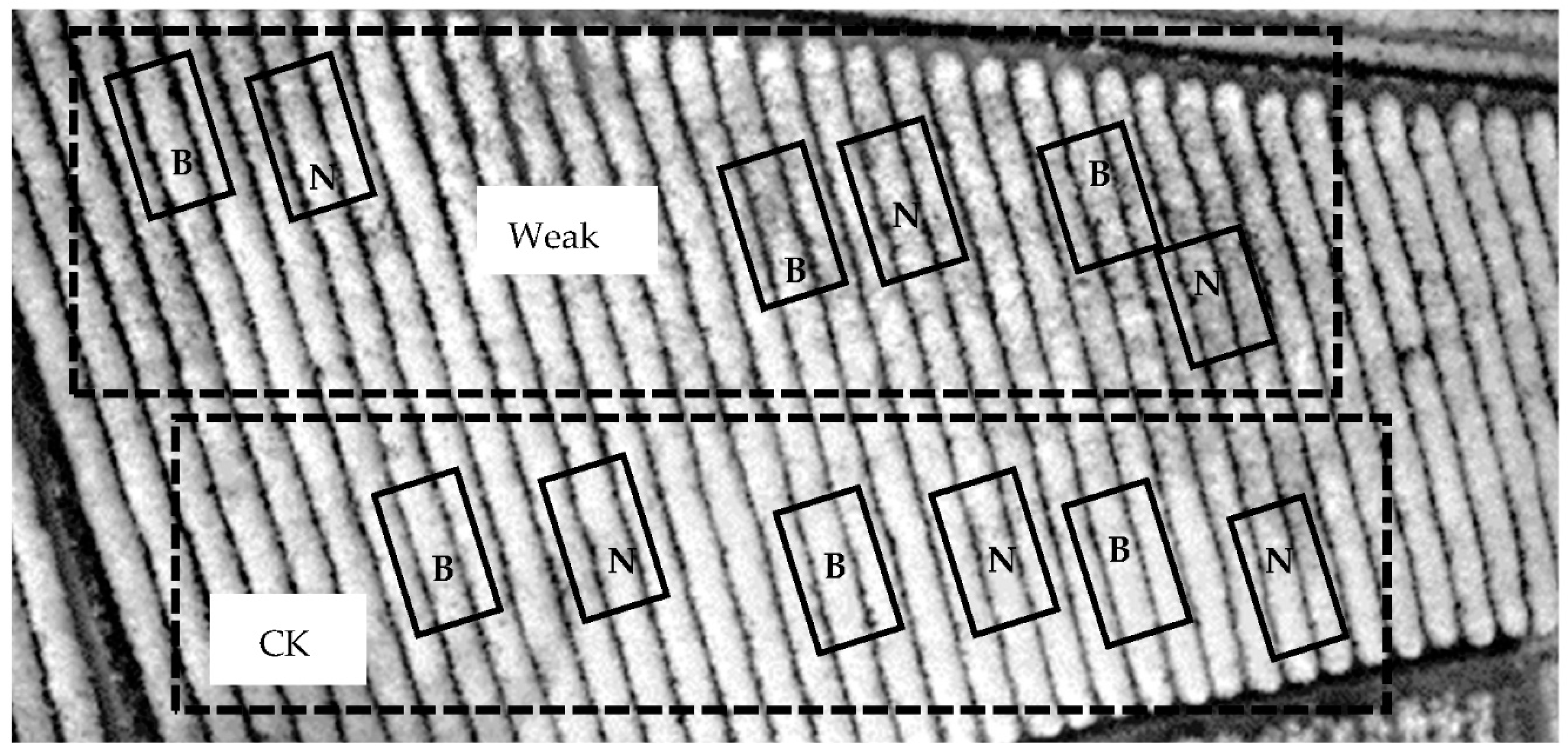
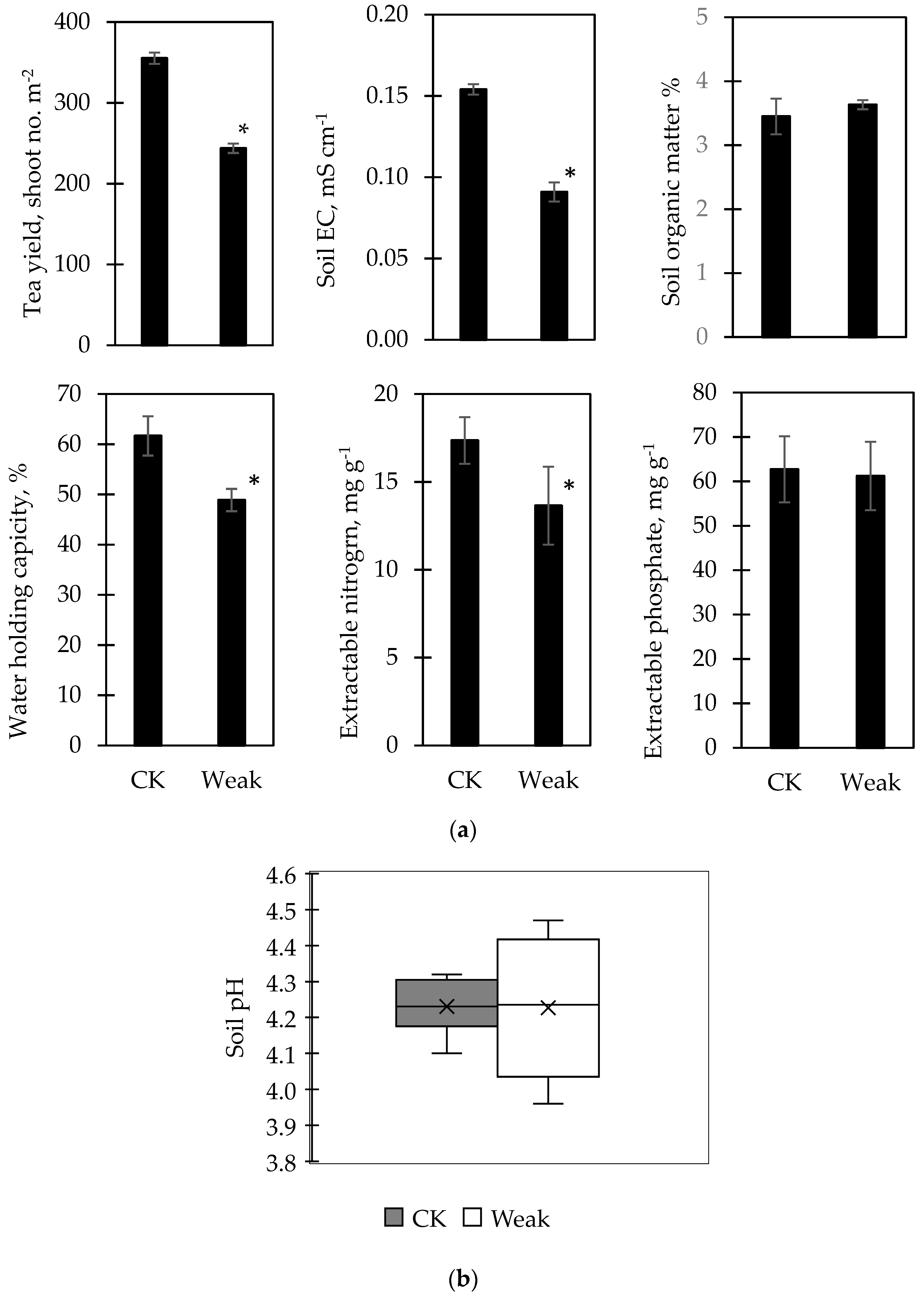
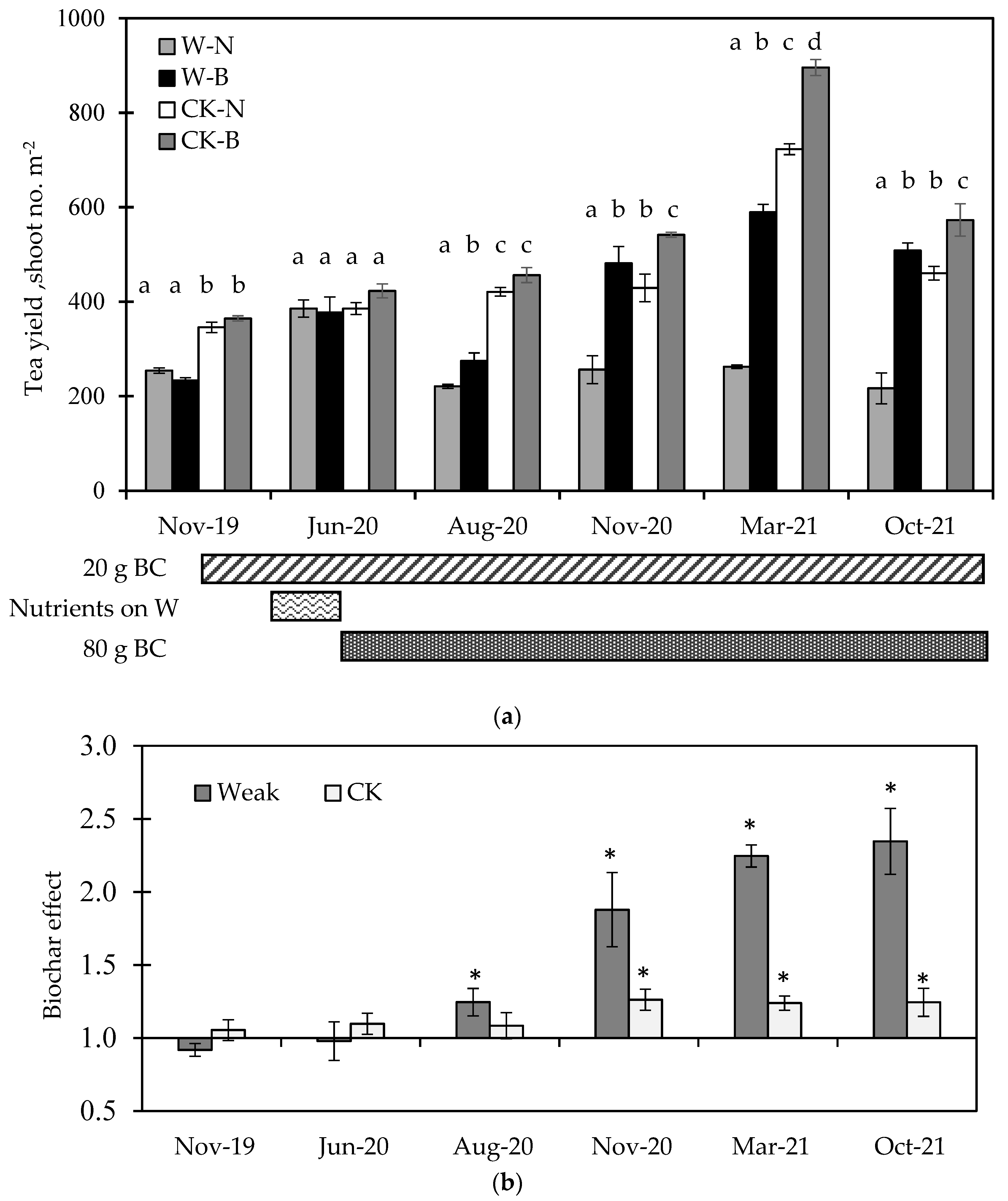

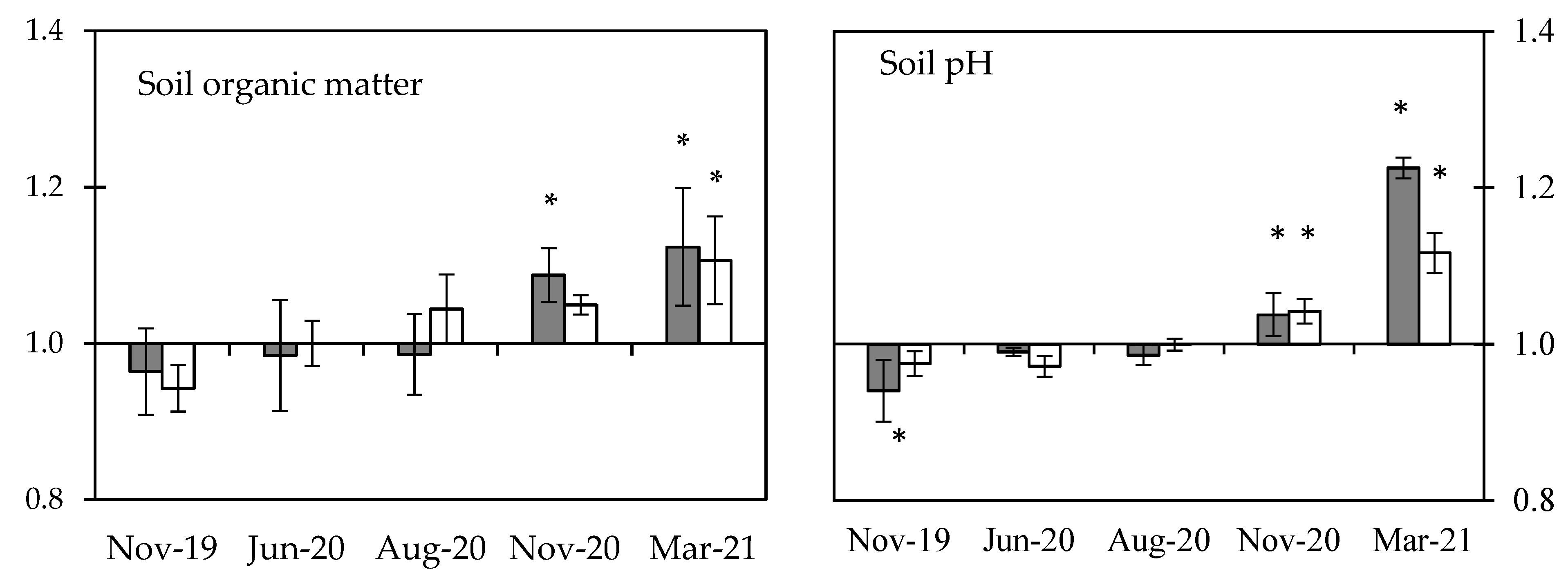
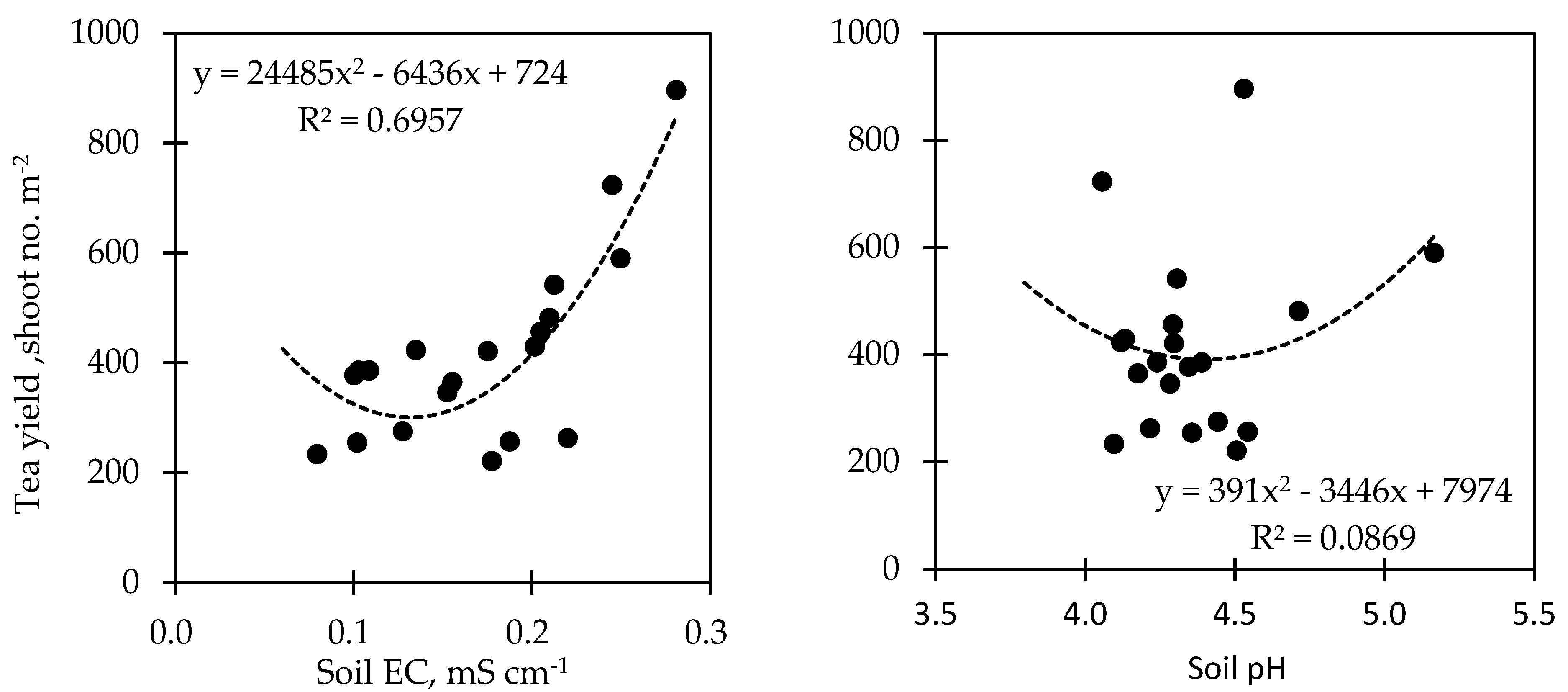

| Pyrolysis Temperature | 450 °C | 600 °C |
|---|---|---|
| pH | 9.1 | 10.3 |
| Surface area (m2 g−1) | 12.1 | 8.9 |
| Water content (wt. %) | 5.6 | 7.0 |
| Volatile compound (wt. %) | 27.7 | 19.8 |
| Fixed carbon (wt. %) | 56.5 | 62.1 |
| Ash (wt. %) | 10.2 | 11.1 |
| C (wt. %) | 71.4 | 73.8 |
| H (wt. %) | 3.2 | 1.8 |
| N (wt. %) | 2.7 | 2.5 |
| S (wt. %) | 0.1 | 0.1 |
| O (wt. %) | 12.4 | 11.1 |
Publisher’s Note: MDPI stays neutral with regard to jurisdictional claims in published maps and institutional affiliations. |
© 2022 by the authors. Licensee MDPI, Basel, Switzerland. This article is an open access article distributed under the terms and conditions of the Creative Commons Attribution (CC BY) license (https://creativecommons.org/licenses/by/4.0/).
Share and Cite
Sipayung, H.N.; Wu, K.-T.; Liu, D.-Y.; Chen, C.-T. Growth Enhancement of Camellia sinensis with Biochar. Processes 2022, 10, 199. https://doi.org/10.3390/pr10020199
Sipayung HN, Wu K-T, Liu D-Y, Chen C-T. Growth Enhancement of Camellia sinensis with Biochar. Processes. 2022; 10(2):199. https://doi.org/10.3390/pr10020199
Chicago/Turabian StyleSipayung, Herta Novalina, Keng-Tung Wu, De-Yu Liu, and Chien-Teh Chen. 2022. "Growth Enhancement of Camellia sinensis with Biochar" Processes 10, no. 2: 199. https://doi.org/10.3390/pr10020199
APA StyleSipayung, H. N., Wu, K.-T., Liu, D.-Y., & Chen, C.-T. (2022). Growth Enhancement of Camellia sinensis with Biochar. Processes, 10(2), 199. https://doi.org/10.3390/pr10020199






